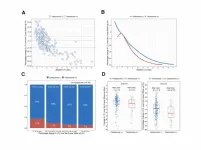(Press-News.org) The interplay of a quartet of sex, marital status, education, and race is linked to an 18 year lifespan gap for US citizens, and while no one factor is more influential than any of the others, the more of these influential factors a person has, the higher their risk of an earlier death, finds research published in the open access journal BMJ Open.
But a simple scoring system based on these characteristics can help overcome this complexity to identify those most at risk, say the researchers.
Individual risks and genetic factors explain part of the differences in health and death, but the evidence increasingly points to the role of social determinants—the conditions in which people are born, grow, live, work and age—in shaping health, explain the researchers.
But when it comes to identifying those groups at high risk of early death, using only one of these factors often masks wide lifespan inequalities within these groups, and various factors influence health in different ways, making it difficult to identify a person at risk, they add.
To better understand how these inequalities act in tandem with one another, and to identify people at high risk of an early death from all, and specific, causes more accurately, the researchers looked at lifespan differences associated with 4 key social determinants, with the aim of drawing up a scoring system.
They extracted information on registered deaths and population numbers from national statistics and census data for the period 2015-19, to analyse the potential influence of all combinations of sex, race, marital status, and education level on the risk of early death—54 different groups in total.
They included 12 specific causes of death, representing the 11 leading causes of death in the US, to include homicide and lung, breast, prostate, and other cancers.
The final analysis is based on partial life expectancy—years lived between the ages of 30 and 80. This revealed very large differences between the 54 groups, with an 18 year difference between those with the shortest and longest partial life expectancies.
For example, White men with a high school diploma or less, who have never married have the shortest partial life expectancy of 37 years. At the other end of the scale, White married women with a university degree can expect to clock up 55 years in partial life expectancy.
But no one factor conferred a clear advantage to all people equally, the researchers found.
For example, university educated White married men have a partial life expectancy of 52 years, which is higher than that of 81% of all the female groups (22 out of 27). Similarly, some groups with low educational attainment outlive some with high educational attainment.
And married Hispanic women educated to high school level or below have a partial life expectancy of 51 years, which is higher than 44% of the groups characterised by a university degree (8 out of 18).
And a characteristic that curtails partial life expectancy can be offset by a characteristic that extends it, and vice versa, say the researchers.
For example, education to high school level or below reduces partial life expectancy by nearly 4 years, but being married and female increases it by almost 5 years, bringing the life expectancy of married women with this level of educational attainment above the national level.
And while a university degree extends partial life expectancy by nearly 4 years, never being married and of male sex shortens it by nearly 5 years, bringing it below the national level.
Based on these findings, the researchers developed a scoring system, ranging from −10 to a maximum of 8, for identifying groups at high risk of early death across the 4 social determinants of health.
Being female (score of 4), and married (0), White (1) and educated to high school level or less (−5) yields a total score of 0. Around half of the 54 groups score 0 or above and nearly 1 in 5 (19%) −5 or lower.
While not everyone in low scoring groups will die early, people in these groups might be at heightened risk, and so might need more medical or public health interventions, explain the researchers.
Marriage and higher educational attainment are two characteristics that always confer lower risk, but the gradient isn’t as obvious for race. Some specific causes of death, such as suicide, unintentional injuries, chronic lung disease and lung cancer adversely affect more Whites, while others, such as liver disease, adversely affect more Hispanics.
Most causes of death tend to adversely affect Blacks across the board. And women generally have a survival advantage over men for all causes of death, except for other cancers and Alzheimer’s disease.
But different social determinants of health affect each cause of death differently, as a result of which, the causes of death contributing to the mortality disadvantage vary across the 54 groups, even if the overall score is the same, the researchers found.
For example, White previously married women with a high school degree or less are at high risk of dying from lung cancer, other cancers, chronic lung disease, Alzheimer’s disease, kidney disease, and influenza and pneumonia.
And Black never married men with a university degree are at higher risk of dying from heart disease, prostate cancer, cerebrovascular diseases, diabetes, kidney disease and homicide. Both these groups have an overall risk score of −3.
The researchers acknowledge that the scoring system could oversimplify underlying factors at play. Marital status is also prone to change. And including more characteristics, such as income, residential area, environmental factors, access to healthcare, or lifestyle could enhance the scoring system’s precision, they suggest.
But they nevertheless conclude: “There is a complex interaction between social and individual determinants of health, with no one determinant explaining the full observed variation in lifespan.
“Having one characteristic that is associated with higher mortality is often not a sufficient criterion to be considered at high risk of mortality, but the risk does increase with the number of such characteristics. In addition, not all analysed social determinants of health have the same degree of influence on lifespan and mortality.”
END
Interplay of sex, marital status, education, race linked to 18 year US lifespan gap
No one factor paramount, but individual risk rises in tandem with number of such factors. Simple scoring system helps overcome this complexity to identify those at risk of early death
2024-08-06
ELSE PRESS RELEASES FROM THIS DATE:
Arizona State University research site designated UNESCO World Heritage Site
2024-08-05
At the edge of the south coast of South Africa, Arizona State University professor Curtis Marean and his research teams have been teasing out the secrets of our earliest modern human ancestors in caves at Pinnacle Point for over 25 years.
In late July, the site was declared a UNESCO World Heritage Site, the Olympic gold medal of heritage, which is only given to sites of “outstanding universal value” to all of humanity.
In 1999, while conducting reconnaissance on the south coast ...
Association between osteoporosis and telomere shortening
2024-08-05
“We sought to identify an association between osteoporosis and LTL shortening in an independent prospective cohort.”
BUFFALO, NY- August 5, 2024 – A new research paper was published on the cover of Aging (listed by MEDLINE/PubMed as "Aging (Albany NY)" and "Aging-US" by Web of Science) Volume 16, Issue 14, entitled, “Association between osteoporosis and the rate of telomere shortening.”
A shorter leukocyte telomere length (LTL) is reported to be associated with age-related diseases, including osteoporosis. Many studies ...
DRI’s STEM education team receives EPA grant to support microplastics education for Nevada students and communities
2024-08-05
Reno, Nev. (August 5, 2024) – DRI’s STEM Education Team has received a grant from the Environmental Protection Agency (EPA) to support environmental education in Nevada’s schools.
The $100,000 grant will fund the production of additional educational kits known as Greenboxes that raise awareness and understanding of the prevalence and role of microplastics in the environment.
“DRI is honored to be awarded this EPA grant, and we are eager to continue our outreach to underserved rural and urban communities across Nevada,” said DRI STEM Education Program Manager Emily McDonald-Williams. “Middle school students ...
Sex bias in pain management at emergency departments new study reveals
2024-08-05
New study reveals a significant sex bias in pain management at emergency departments, showing that female patients are consistently less likely to receive pain medication prescriptions compared to male patients with similar complaints. This bias persists across different ages, pain levels, and physician sex, indicating a systemic issue. Female patients' pain scores are less frequently recorded, and they spend more time in the emergency department than male patients. The findings highlight the need for urgent policy interventions and training for healthcare ...
Child Mind Institute paper reveals next frontier in reproducible brain imaging for neuroscience discovery
2024-08-05
New York, NY (August 5, 2024) — The Child Mind Institute has released a paper detailing their pioneering study in the journal Nature Human Behaviour titled, "Moving Beyond Processing and Analysis-Related Variation in Resting State Functional Brain Imaging." The research identifies significant challenges in the reproducibility and standardization of functional magnetic resonance imaging (fMRI) used to understand brain function and behavior — and proposes concrete solutions to move the field towards results that translate into real world impact.
Along with a diverse team of international collaborators, ...
Hospital pneumonia diagnoses are uncertain, revised more than half the time, study finds
2024-08-05
Pneumonia diagnoses are marked by pronounced uncertainty, an AI-based analysis of over 2 million hospital visits has found.
More than half the time, a pneumonia diagnosis made in the hospital will change from a patient’s entrance to their discharge—either because someone who was initially diagnosed with pneumonia ended up with a different final diagnosis, or because a final diagnosis of pneumonia was missed when a patient entered the hospital (not including cases of hospital-acquired pneumonia).
The study describing the new results publishes August 6th in Annals of Internal Medicine.
Barbara Jones, MD, MSCI, pulmonary and critical care physician ...
Cancer screening estimated to cost $43 billion a year in the United States
2024-08-05
Embargoed for release until 5:00 p.m. ET on Monday 5 August 2024
Annals of Internal Medicine Tip Sheet
@Annalsofim
Below please find summaries of new articles that will be published in the next issue of Annals of Internal Medicine. The summaries are not intended to substitute for the full articles as a source of information. This information is under strict embargo and by taking it into possession, media representatives are committing to the terms of the embargo not only on their own behalf, but also on behalf of the organization they represent.
----------------------------
1. ...
Researchers receive 9.5 million grant to study relationship between polyphenol intake, Alzheimer’s prevention, and the brain-gut-microbiome system
2024-08-05
UCLA Health researchers, in collaboration with researchers from the Republic of Ireland and Northern Ireland, have received $9.5 million award from the National Institutes of Health (NIH) with support from European funding agencies — The Science Foundation Ireland (SFI) and the Public Health Agency Health & Social Care (HSC) — to study the effects of polyphenols on cognitive health and the brain-gut microbiome system.
The proposal, named MAEVE, stands for “Microbiota mediated flavonoid metabolites for cognitive health.”
In this interdisciplinary and multicenter study funded through the Tripartite US-Ireland Research & Development Partnership Program, ...
UH astronomers uncover risks to planets that could host life
2024-08-05
A groundbreaking study has revealed that red dwarf stars can produce stellar flares that carry far-ultraviolet (far-UV) radiation levels much higher than previously believed. This discovery suggests that the intense UV radiation from these flares could significantly impact whether planets around red dwarf stars can be habitable. Led by current and former astronomers from the University of Hawaiʻi Institute for Astronomy (IfA), the research was recently published in the Monthly Notices of the Royal Astronomical Society.
“Few stars have been thought to generate ...
An overlooked side-effect of the housing crisis may be putting Californians at increased risk from climate disasters
2024-08-05
In a new article for the journal Proceedings of the National Academy of Sciences, UC Santa Cruz researchers laid out the foundation for their highly-anticipated upcoming study of how lack of affordable housing in urban areas of California may be driving increased development in and near wildlands, leading to more severe climate change impacts.
Since the 1990s, California has led the nation in the growth of Wildland-Urban Interface (WUI) development, with more than one in three households in the state now located immediately next to or within ...
LAST 30 PRESS RELEASES:
Eye for trouble: Automated counting for chromosome issues under the microscope
The vast majority of US rivers lack any protections from human activities, new research finds
Ultrasound-responsive in situ antigen "nanocatchers" open a new paradigm for personalized tumor immunotherapy
Environmental “superbugs” in our rivers and soils: new one health review warns of growing antimicrobial resistance crisis
Triple threat in greenhouse farming: how heavy metals, microplastics, and antibiotic resistance genes unite to challenge sustainable food production
Earthworms turn manure into a powerful tool against antibiotic resistance
AI turns water into an early warning network for hidden biological pollutants
Hidden hotspots on “green” plastics: biodegradable and conventional plastics shape very different antibiotic resistance risks in river microbiomes
Engineered biochar enzyme system clears toxic phenolic acids and restores pepper seed germination in continuous cropping soils
Retail therapy fail? Online shopping linked to stress, says study
How well-meaning allies can increase stress for marginalized people
Commercially viable biomanufacturing: designer yeast turns sugar into lucrative chemical 3-HP
Control valve discovered in gut’s plumbing system
George Mason University leads phase 2 clinical trial for pill to help maintain weight loss after GLP-1s
Hop to it: research from Shedd Aquarium tracks conch movement to set new conservation guidance
Weight loss drugs and bariatric surgery improve the body’s fat ‘balance:’ study
The Age of Fishes began with mass death
TB harnesses part of immune defense system to cause infection
Important new source of oxidation in the atmosphere found
A tug-of-war explains a decades-old question about how bacteria swim
Strengthened immune defense against cancer
Engineering the development of the pancreas
The Journal of Nuclear Medicine ahead-of-print tip sheet: Jan. 9, 2026
Mount Sinai researchers help create largest immune cell atlas of bone marrow in multiple myeloma patients
Why it is so hard to get started on an unpleasant task: Scientists identify a “motivation brake”
Body composition changes after bariatric surgery or treatment with GLP-1 receptor agonists
Targeted regulation of abortion providers laws and pregnancies conceived through fertility treatment
Press registration is now open for the 2026 ACMG Annual Clinical Genetics Meeting
Understanding sex-based differences and the role of bone morphogenetic protein signaling in Alzheimer’s disease
Breakthrough in thin-film electrolytes pushes solid oxide fuel cells forward
[Press-News.org] Interplay of sex, marital status, education, race linked to 18 year US lifespan gapNo one factor paramount, but individual risk rises in tandem with number of such factors. Simple scoring system helps overcome this complexity to identify those at risk of early death




